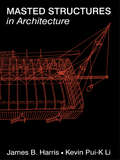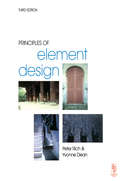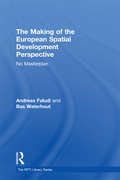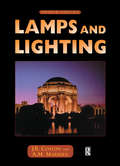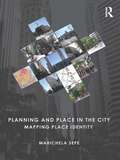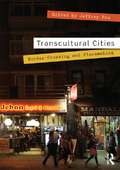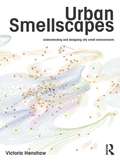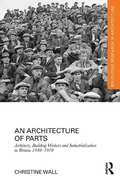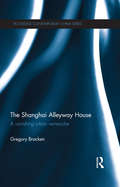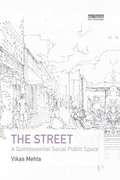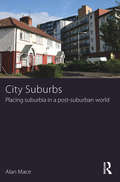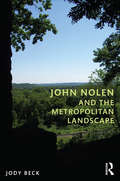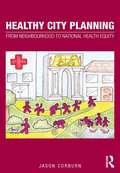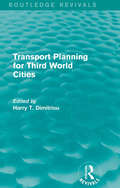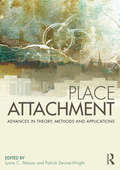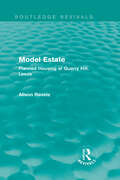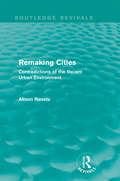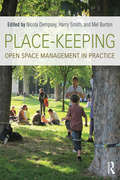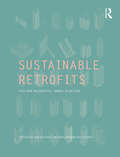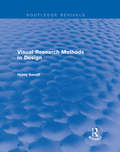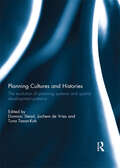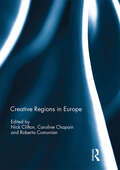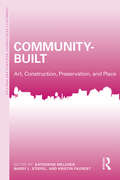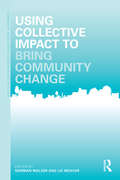- Table View
- List View
Tony Hunt's Second Sketchbook
by Tony Hunt Sir Norman FosterTony Hunt's Sketchbook illustrates the connection between brain and hand in conceiving structural concepts and details as possible solutions to structures in architecture. This new edition features 100 previously unpublished sketches. These sketches illustrate alternative structural concepts, ideas and details developed by Tony Hunt for over one hundred projects throughout his professional life. They relate directly to projects built and unbuilt in the field of structural engineering and were either produced at the time of relevant design meetings or as a response to a problem posed by an architect and are, therefore, a record of ideas proposed at the particular time. They are a source of design inspiration and an insight into the work of this well respected engineer.
Masted Structures in Architecture
by James Harris Kevin LiThis is the first fully comprehensive survey and analysis of masted structures and covers examples that have evolved during the past three decades.Masted Structures are one of the most interesting developments in post-war architecture resulting from a combination of technology, structural engineering theory and a collaboration between architects and engineers. This is an essential guide for architects to the structural and constructional implications of masted forms in relation to space enclosure, patterns of loading and use of differing materials and techniques. This useful volume will enable architects and engineers to understand the origins, development and nature of masted structures and will provide a stimulating basis for future design.
Principles of Element Design
by Yvonne Dean Peter RichThe construction of buildings is learnt through experience and the inheritance of a tradition in forming buildings over several thousand years. Successful construction learns from this experience which becomes embodied in principles of application. Though materials and techniques change, various elements have to perform the same function. 'Principles of Element Design' identifies all the relevant elements and then breaks these elements down into all their basic constituents, making it possible for students to fully understand the given theory and principles behind each part. As all building projects are subject to guidance through the Building Regulations and British Standards, this book gives an immediate reference back to relevant information to help practitioners and contractors identify key documents needed.Yvonne Dean B.A. (Hons) B.A (Open) RIBA, an architect, energy consultant and materials technologist. She also has 15 years experience as a lecturer, travels widely and is a guest lecturer at many universities. She pioneered an access course for Women into Architecture and Building, which has been used as a template by others, and has been instrumental in helping to change the teaching of technology for architects and designers.Peter Rich AA Dipl. (Hons) Architect, started his career with 14 years experience as a qualified architectural technician. He then joined the AA School of Architecture, working with Bill Allen and John Bickerdike after his graduation, later becoming a partner of Bickerdike Allen Rich and Partners. He also taught building construction at the Bartlett School of Architecture, University College London, and architectural design at the Polytechnic of North London. He now acts as a Consultant.
The Making of the European Spatial Development Perspective: No Masterplan (RTPI Library Series)
by Andreas Faludi Bas WaterhoutThe European Spatial Development Perspective (ESDP) is published in eleven official EU languages and so is the most international planning policy document that exists. This book is the only comprehensive account of the process of preparing, negotiating and adopting this document. It outlines the differing perspectives of the European member states and shows that the last thing its proponents wanted is a masterplan. The Making of the European Spatial Development Perspective is a unique book offering a snapshot of contemporary European spatial planning.
Lamps and Lighting
by M.A. CaylessThis book is a comprehensive guide to the theory and practice of lighting. Covering the physics of light production, light sources, circuits and a wide variety of lighting applications, it is both suitable as a detailed textbook and as thoroughly practical guide for practising lighting engineers. This fourth edition of Lamps and Lighting has been completely updated with new chapters on the latest lamp technology and applications. The editors ahve called upon a wide range of expertise and as a result many sections have been broadened to include both European and US practice.The book begins with a description of the fundamentals of light, vision, colour and measurement. Part II, the main section of the book, deals with lamps and control equipment and includes descriptions of all lamp types in use today. Part III on lighting covers both interior and exterior applications.
Planning and Place in the City: Mapping Place Identity
by Marichela SepeUnder the influence of globalization, the centres of many cities in the industrialised world are losing their place identity, the set of cultural markers that define a city’s uniqueness and make it instantly recognisable. A key task for planners and residents, working together, is to preserve that unique sense of place without making the city a parody of itself. In Planning and Place in the City, Marichela Sepe explores the preservation, reconstruction and enhancement of cultural heritage and place identity. She outlines the history of the concept of placemaking, and sets out the range of different methods of analysis and assessment that are used to help pin down the nature of place identity. This book also uses the author's own survey-based method called PlaceMaker to detect elements that do not feature in traditional mapping and identifies appropriate planning interventions. Case studies investigate cities in Europe, North America and Asia, which demonstrate how surveys and interviews can be used to draw up an analytical map of place identity. This investigative work is a crucial step in identifying cultural elements which will influence what planning decisions should be taken in the future. The maps aim to establish a dialogue with local residents and support planners and administrators in making sustainable changes. The case studies are amply illustrated with survey data sheets, photos, and coloured maps. Innovative and broad-based, Planning and Place in the City lays out an approach to the identification and preservation of place and cultural heritage suitable for students, academics and professionals alike.
Transcultural Cities: Border-Crossing and Placemaking
by Jeffrey HouTranscultural Cities uses a framework of transcultural placemaking, cross-disciplinary inquiry and transnational focus to examine a collection of case studies around the world, presented by a multidisciplinary group of scholars and activists in architecture, urban planning, urban studies, art, environmental psychology, geography, political science, and social work. The book addresses the intercultural exchanges as well as the cultural trans-formation that takes place in urban spaces. In doing so, it views cultures not in isolation from each other in today’s diverse urban environments, but as mutually influenced, constituted and transformed. In cities and regions around the globe, migrations of people have continued to shape the makeup and making of neighborhoods, districts, and communities. For instance, in North America, new immigrants have revitalized many of the decaying urban landscapes, creating renewed cultural ambiance and economic networks that transcend borders. In Richmond, BC Canada, an Asian night market has become a major cultural event that draws visitors throughout the region and across the US and Canadian border. Across the Pacific, foreign domestic workers in Hong Kong transform the deserted office district in Central on weekends into a carnivalesque site. While contributing to the multicultural vibes in cities, migration and movements have also resulted in tensions, competition, and clashes of cultures between different ethnic communities, old-timers, newcomers, employees and employers, individuals and institutions. In Transcultural Cities Jeffrey Hou and a cross-disciplinary team of authors argue for a more critical and open approach that sees today’s cities, urban places, and placemaking as vehicles for cross-cultural understanding.
Urban Smellscapes: Understanding and Designing City Smell Environments
by Victoria HenshawWe see the city, we hear the city, but above all: we smell the city. Scent has unique qualities: ubiquity, persistence, and an unparalleled connection to memory, yet it has gone overlooked in discussions of sensory design. What scents shape the city? How does scent contribute to placemaking? How do we design smell environments in the city? Urban Smellscapes makes a notable contribution towards the growing body of literature on the senses and design by providing some answers to these questions and contributing towards the wider research agenda regarding how people sensually experience urban environments. It is the first of its kind in examining the role of smell specifically in contemporary experiences and perceptions of English towns and cities, highlighting the perception of urban smellscapes as inter-related with place perception, and describing odour’s contribution towards overall sense of place. With case studies from factories, breweries, urban parks, and experimental smell environments in Manchester and Grasse, Urban Smellscapes identifies processes by which urban smell environments are managed and controlled, and gives designers and city managers tools to actively use smell in their work.
An Architecture of Parts: Architects, Building Workers, And Industrialization In Britain, 1940-1970 (Routledge Research in Architecture)
by Christine WallThis book is unique in describing the history of post war reconstruction from an entirely new perspective by focusing on the changing relationship between architects and building workers. It considers individual, as well as collective, interactions with technical change and in doing so brings together, for the first time, an extraordinary range of sources including technical archives, oral history and visual material to describe the construction process both during and in the decades after the war. It focuses on the social aspects of production and the changes in working life for architects and building workers with increasing industrialization, in particular analysing the effect on the building process of introducing dimensionally co-ordinated components. Both architects and building workers have been accused of creating a built environment now popularly discredited: architects responsible for poor design and building workers for poor workmanship. However, many of the structures and ideas underpinning this period of rapid change were revolutionary in their commitment to a complete transformation of the building process. An Architecture of Parts adds to the growing literature on changes in the building world during and immediately after the Second World War. It is significant, both empirically and historically, in its examination of the ideas, technology and relationships that fired industrialization of the building process in mid-century Britain.
The Shanghai Alleyway House: A Vanishing Urban Vernacular (Routledge Contemporary China Series)
by Gregory BrackenAs a nineteenth-century commercial development, the alleyway house was a hybrid of the traditional Chinese courtyard house and the Western terraced one. Unique to Shanghai, the alleyway house was a space where the blurring of the boundaries of public and private life created a vibrant social community. In recent years however, the city’s rapid redevelopment has meant that the alleyway house is being destroyed, and this book seeks to understand it in terms of the lifestyle it engendered for those who called it home, whilst also looking to the future of the alleyway house. Based on groundwork research, this book examines the Shanghai alleyway house in light of the complex history of the city, especially during the colonial era. It also explores the history of urban form (and governance) in China in order to question how the Eastern and Western traditions combined in Shanghai to produce a unique and dynamic housing typology. Construction techniques and different alleyway house sub-genres are also examined, as is the way of life they engendered, including some of the side-effects of alleyway house life, such as the literature it inspired, both foreign and local, as well as the portrayal of life in the laneways as seen in films set in the city. The book ends by posing the question: what next for the alleyway house? Does it even have a future, and if so, what lies ahead for this rapidly vanishing typology? This interdisciplinary book will be welcomed by students and scholars of Chinese studies, architecture and urban development, as well as history and literature.
The Street: A Quintessential Social Public Space
by Vikas MehtaReceived the Environmental Design Research Association's 2014 Place Book Award Shortlisted for the UDG Francis Tibbalds Book Award 2014 Good cities are places of social encounter. Creating public spaces that encourage social behavior in our cities and neighborhoods is an important goal of city design. One of the cardinal roles of the street, as public space, is to provide a setting for sociability. How do we make sociable streets? This book shows us how these ordinary public spaces can be planned and designed to become settings that support an array of social behaviors. Through carefully crafted research, The Street systematically examines people's actions and perceptions, develops a comprehensive typology of social behaviors on the neighborhood commercial street and provides a thorough inquiry into the social dimensions of streets. Vikas Mehta shows that sociability is not a result of the physical environment alone, but is achieved by the relationships between the physical environment, the land uses, their management, and the places to which people assign special meanings. Scholars and students of urban design, planning, architecture, geography and sociology will find the book a stimulating resource. The material is also directly applicable to practice and should be widely read by professional urban designers, planners, architects, and others involved in the design, planning, and implementation of commercial streets.
City Suburbs: Placing suburbia in a post-suburban world
by Alan MaceThe majority of the world’s population is now urban, and for most this will mean a life lived in the suburbs. City Suburbs considers contemporary Anglo-American suburbia, drawing on research in outer London it looks at life on the edge of a world city from the perspective of residents. Interpreted through Bourdieu’s theory of practice it argues that the contemporary suburban life is one where place and participation are, in combination, strong determinants of the suburban experience. From this perspective suburbia is better seen as a process, an on-going practice of the suburban which is influenced but not determined by the history of suburban development. How residents engage with the city and the legacy of particular places combine powerfully to produce very different experiences across outer London. In some cases suburban residents are able to combine the benefits of the city and their residential location to their advantage but in marginal middle-class areas the relationship with the city is more circumspect as the city represents more threat than opportunity. The importance of this relational experience with the city informs a call to integrate more fully the suburbs into studies of the city.
John Nolen and the Metropolitan Landscape
by Jody Beck"A model city, the hope of democracy" – John Nolen on his suggested plans for Madison, Wisconsin This book connects John Nolen's political and social visions with his design proposals by analyzing his extensive writings, personal correspondence and some of his most significant works. While John Nolen is best known as a city planner, he trained as a landscape architect and used the titles 'landscape architect' and 'city planner' interchangeably throughout his career. A prolific practitioner, he was engaged in nearly 400 projects throughout the United States between 1905 and 1936, including town planning, industrial housing, state and city parks, new towns and regional planning. Focusing particularly on several projects central to Nolen’s career including Madison (WI), Mariemont (OH), Venice (FL) and Penderlea (NC), Beck investigates the ideologies that underpinned Nolen’s work. This is a rare look at a key figure in the development of 20th century American cities.
Healthy City Planning: From Neighbourhood to National Health Equity (Planning, History and Environment Series)
by Jason CorburnHealthy city planning means seeking ways to eliminate the deep and persistent inequities that plague cities. Yet, as Jason Corburn argues in this book, neither city planning nor public health is currently organized to ensure that today’s cities will be equitable and healthy. Having made the case for what he calls ‘adaptive urban health justice’ in the opening chapter, Corburn briefly reviews the key events, actors, ideologies, institutions and policies that shaped and reshaped the urban public health and planning from the nineteenth century to the present day. He uses two frames to organize this historical review: the view of the city as a field site and as a laboratory. In the second part of the book Corburn uses in-depth case studies of health and planning activities in Rio de Janeiro, Nairobi, and Richmond, California to explore the institutions, policies and practices that constitute healthy city planning. These case studies personify some of the characteristics of his ideal of adaptive urban health justice. Each begins with an historical review of the place, its policies and social movements around urban development and public health, and each is an example of the urban poor participating in, shaping, and being impacted by healthy city planning.
Transport Planning for Third World Cities (Routledge Revivals)
by Harry T. DimitriouCities within the developing world experience a form of urban development which is different to those in more industrialised countries. Rates of growth are usually much more dramatic, housing and transport are often provided informally, and institutional support for urban management is also much weaker. The crux of this book, first published in 1990, lies in the idea that urban transport planning cannot be viewed in isolation from this wider development context. Making special reference to a number of countries, including Brazil, India and Indonesia, chapters discuss problems of urban transport planning, deficiencies in the theory and practice of conventional transport planning, and the emerging alternatives in the countries under examination. This work addresses problems that are still of great concern to urban policy planners, professionals and academics, as well as students from the fields of development studies, urban geography and planning, architecture and civil engineering.
Place Attachment: Advances in Theory, Methods and Applications
by Lynne C. Manzo Patrick Devine-WrightRecipient of the 2014 EDRA Achievement Award. Place attachments are emotional bonds that form between people and their physical surroundings. These connections are a powerful aspect of human life that inform our sense of identity, create meaning in our lives, facilitate community and influence action. Place attachments have bearing on such diverse issues as rootedness and belonging, placemaking and displacement, mobility and migration, intergroup conflict, civic engagement, social housing and urban redevelopment, natural resource management and global climate change. In this multidisciplinary book, Manzo and Devine-Wright draw together the latest thinking by leading scholars from around the globe, capturing important advancements in three areas: theory, methods and application. In a wide range of conceptual and applied ways, the authors critically review and challenge contemporary knowledge, identify significant advances and point to areas for future research. This volume offers the most current understandings about place attachment, a critical concept for the environmental social sciences and placemaking professions.
Model Estate: Planned Housing at Quarry Hill, Leeds (Routledge Revivals)
by Alison RavetzQuarry Hill Flats, once both the pride and shame of its city of Leeds, was an iconic Modernist symbol of the 1930s. It marked the first use of a prefabricated building system for a large-scale council estate, replacing a notorious slum. But it lasted barely a generation – its complete demolition was announced as Alison Ravetz was finishing this study. First published in 1974, this book is unique in its use of all estate records from conception to destruction, as well as in its comprehensive approach, including aspects usually missing in council housing studies – notably the intimate experience of residents, and a fraught, long-drawn-out building period. Ravetz argues that the Flats’ ‘failure’ was due not to social breakdown, as repeatedly alleged, but rather to a rigidity of design and management unable to accommodate gradual, incremental change. This has continuing implications for the operation of bureaucratically designed and controlled ‘social housing’ today.
Remaking Cities: Contradictions of the Recent Urban Environment (Routledge Revivals)
by Alison RavetzThis book, published in 1980, is an iconoclastic account of one of the pillars of the welfare state, British town and country planning, between 1945 and 1975. Always a fine balance between central control and market forces, it was challenged by strains within and between the environmental professions and protest by people dispossessed or alienated by re-shaped urban environments. Remaking Cities critiques the export of western-style planning to the developing world and reviews initiatives rooted in different understandings of ‘growth’ appearing in those years. Nearly forty years on, many of the same issues beset us, notably the depressingly familiar inner city problem, despite countless reports, funds and ‘programmes’. But now our infrastructure and services, once publicly owned, are privatised and fragmented, and local government progressively relegated. The very core of planning, development control, is being pared in a struggle to regain the ‘growth’ which led to our current crisis. This gives fresh importance to the need for new modes of creating liveable, sustainable environments, emphasised in this important work.
Place-Keeping: Open Space Management in Practice
by Harry Smith Nicola Dempsey Mel BurtonPlace-Keeping presents the latest research and practice on place-keeping – that is, the long-term management of public and private open spaces – from around Europe and the rest of the world. There has long been a focus in urban landscape planning and urban design on the creation of high-quality public spaces, or place-making. This is supported by a growing body of research which shows how high-quality public spaces are economically and socially beneficial for local communities and contribute positively to residents’ quality of life and wellbeing. However, while large amounts of capital are spent on the creation of open spaces, little thought is given to, and insufficient resources made available for, the long-term maintenance and management of public spaces, or place-keeping. Without place-keeping, public spaces can fall into a downward spiral of disrepair where anti-social behaviour can emerge and residents may feel unsafe and choose to use other spaces. The economic and social costs of restoring such spaces can therefore be considerable where place-keeping does not occur. Place-Keeping also provides an accessible presentation of the outputs of a major European Union-funded project MP4: Making Places Profitable, Public and Private Open Spaces which further extends the knowledge and debate on long-term management of public and private spaces. It will be an invaluable resource for students, academics and practitioners seeking critical but practical guidance on the long-term management of public and private spaces in a range of contexts.
Sustainable Retrofits: Post War Residential Towers in Britain
by Asterios Agkathidis Rosa Urbano GutiérrezPresenting the state-of-the-art in sustainable retrofits in post war residential towers, this book captures and re-informs the current intense refurbishing process that is taking place in Britain, which is part of a global phenomenon happening all over the world, as cities upgrade their building stock in an attempt to comply with governmental emission reduction targets. The authors present inspections of 20 sustainably retrofitted social housing towers, analysing their aesthetic and technical modifications, as well as the shifts occurring in their social structure. The authors use over 200 full colour plans, elevations, photographs, maps and illustrations to beautifully support the statistical and analytical information collected. Finally they include interviews with some of the architects who designed the retrofits, residents and key stakeholders to inform the conclusions.
Visual Research Methods in Design (Routledge Revivals)
by Henry SanoffFirst published in 1991, this book is about applications and issues relating to the visual environment. The content pertains to the understanding of human behaviour in the environment by recording behaviour and actions or by direct interaction with people. The author examines research and planning methods that primarily stress the visual features of the physical environment. Traditionally, environmental research has relied on verbal descriptions and perceptions of the physical environment, virtually ignoring the visual component and the potential application of the social sciences for gathering this data. Various strategies that can expand the visual information base have been explored here: diagramming, photo-interviewing, photo-sorting, mapping, notation, simulation, videotaping, and CADD.
Planning Cultures and Histories: The evolution of Planning Systems and Spatial Development Patterns
by Dominic Stead, Jochem de Vries and Tuna Tasan-KokThis book addresses the influences of planning cultures and histories on the temporal evolution of planning systems and spatial development. As well as providing an international comparative perspective on these issues, the contributions to the book also engage in a search for new conceptual frameworks and alternative points of view to better understand and explain these differences. The book makes three main academic contributions. First, it catalogues some of the key changes in planning systems and the impact on spatial development patterns. Second, it examines the interrelationship between planning cultures and histories from a path-dependency perspective. Third, it discusses the variations in physical development patterns resulting from different planning cultures and histories. Chapters from different parts of the European continent present evidence at different scales to illustrate these aspects. In all cases, the specific combinations of political, ideological, social, economic and technological factors are important determinants of urban and regional planning trajectories as well as spatial development patterns. This book was previously published as a special issue of European Planning Studies.
Creative Regions in Europe
by Nick Clifton Caroline Chapain Roberta ComunianCreative and cultural industries, broadly defined, are now considered by many policy makers across Europe at the heart of their national innovation and economic development agenda. Similarly, many European cities and regions have adopted policies to support and develop these industries and their local support infrastructures. However this policy-making agenda implicitly incorporates (and indeed often conflates) elements of cultural and creative industries, the creative class and so on, which are typically employed without due consideration of context. Thus a better understanding is required. To this end, this book features eight research papers, split evenly with regard to geographical focus between the UK and continental Europe (the latter covering Spain, Germany, France, Luxemburg and Belgium individually and in combination). There is also a similar division in terms of those focusing primarily on the policy level (the chapters of Clifton and Macaulay, Mould and Comunian, Pareja-Eastaway and Pradel i Miquel, Perrin) and those of the individual creative actor (the chapters of Alfken et al, Bennett et al, Wedemeier and Brown). This book was previously published as a special issue of European Planning Studies.
Community-Built: Art, Construction, Preservation, and Place (Community Development Research and Practice Series)
by Katherine Melcher Barry Stiefel Kristin FaurestThroughout history and around the world, community members have come together to build places, be it settlers constructing log cabins in nineteenth-century Canada, an artist group creating a waterfront gathering place along the Danube in Budapest, or residents helping revive small-town main streets in the United States. What all these projects have in common is that they involve local volunteers in the construction of public and community places; they are community-built. Although much attention has been given to specific community-built movements such as public murals and community gardens, little has been given to defining community-built as a whole. This volume provides a preliminary description of community-built practices with examples from the disciplines of urban design, historic preservation, and community art. Taken as a whole, these community-built projects illustrate how the process of local involvement in adapting, building, and preserving a built environment can strengthen communities and create places that are intimately tied to local needs, culture, and community. The lessons learned from this volume can provide community planners, grassroots facilitators, and participants with an understanding of what can lead to successful community-built art, construction, preservation, and placemaking.
Using Collective Impact to Bring Community Change (Community Development Research and Practice Series)
by Norman Walzer Liz WeaverCollective Impact as a tool to bring about community change has seen remarkable growth in usage since 2011. Collective Impact has been used successfully with a variety of local issues and has raised the consciousness of how community groups interact as well as the approaches that can lead to long-term innovations. This edited volume sets forth conceptual foundations for using Collective Impact as well as sharing basic approaches that have succeeded in projects under diverse circumstances. It will be useful for both academics and practitioners as Collective Impact continues to undergo substantial changes in focus and direction. Building on Kania and Kramer’s influential work, it provides readers with detailed insights not only into how the Collective Impact system works but also innovative applications to issues facing community developers. The diverse topics shared by the contributing authors make this volume especially important for practitioners designing programs to bring about long-term changes in their communities. Including discussion about how Collective Impact has succeeded in different governmental settings, this book demonstrates how Collective Impact has been modified to accommodate the associated cultural differences with 10 chapters written by experienced on-the-ground community development experts.

